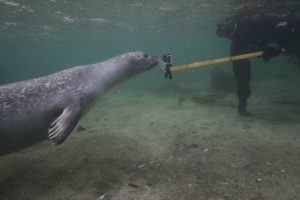Seals
Seals, walruses and sea lions are all classified as pinnipeds, which is a division of carnivorous mammals with flippers. These aquatic marine mammals share a common ancestor with the bears of the world.
Grey seals (Halichoerus grypus) and harbor seals (Phoca vitulina, photo and movie) are the only two that bear young on Iceland’s shores. Harbour seals are common all around Iceland and are frequently seen close to shore. It is best to see them in remote areas as they are shy and usually avoid people. At least they do so on land where they are clumsy. In water they are agile and are often more curious than afraid of people.
Grey seals are much rarer in norther Iceland than in the south. They are even more shy than the harbour seals and stay further away from the main coast. One is therefore lucky to spot the grey seal off the northern coast. The Icelandic names for these seals mirror this, harbour seal is “land seal” and grey seal is “outer seal”.
The most common seal species in the world are all living on the edge of the sea ice in the Arctic and the Antarctic.
The ice edge is usually some distance north and west of Iceland but the seal species that breed there are all regular visitors to northern Iceland. These are walrus (Odobenus rosmarus), hooded seal (Cystophora cristata), harp seal (Pagophilus groenlandica), bearded seal (Erignathus barbatus) and ringed seal (Pusa hispida). If one sees a seal off northern Iceland in winter it is most likely one of these.



 This project (EDU-ARCTIC) has received funding from the European Union’s Horizon 2020 research and innovation programme under grant agreement No 710240. The content of the website is the sole responsibility of the Consortium and it does not represent the opinion of the European Commission, and the Commission is not responsible for any use that might be made of information contained.
This project (EDU-ARCTIC) has received funding from the European Union’s Horizon 2020 research and innovation programme under grant agreement No 710240. The content of the website is the sole responsibility of the Consortium and it does not represent the opinion of the European Commission, and the Commission is not responsible for any use that might be made of information contained.